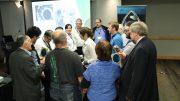CERN, the European Organization for Nuclear Research, has tentatively confirmed that the new particle measured early last July is a Higgs boson. In a press release, they described it for the first time as a Higgs boson rather than a “Higgs-like particle.” Much work remains before the particle’s exact nature can be determined, but everything that has been discovered so far seems to conform to the predictions of the Standard Model of particle physics.
In July, 2012, CERN scientists announced that they had discovered a particle with a mass of around 125.3 gigaelectronvolts (GeV). This is in the range where the Higgs was expected to be found. However, it remained to be seen whether the particle behaved in the way predicted by the Standard Model. This had to be determined through a laborious analysis of data.
Since that time, CERN scientists have poured over 2.5 times as much data. Measurements were taken independently by ATLAS and CMS – the two particle detectors at the Large Hadron Collider (LHC). Their analysis has established two of the particle’s quantum properties: its spin, the particle’s inherent angular momentum; and its parity, which indicates whether the particle’s behaviour is symmetrical or not. They found, as predicted by the Standard Model of particle physics, that the particle discovered in July has positive parity and no spin. This, along with measurements of the particle’s interaction with other particles, “strongly indicates” a Higgs boson.
“The preliminary results with the full 2012 data set are magnificent and to me it is clear that we are dealing with a Higgs boson though we still have a long way to go to know what kind of Higgs boson it is,” stated Joe Incandela, a CMS spokesperson.
What we know of the particle’s behaviour matches what is expected of the Higgs. But there is still a lot of data to collect and analyze before its nature will be well understood. Many scientists are hoping that this boson is not quite the same as the Standard Model Higgs – in fact, that scenario would be “the real five-star disaster,” as CERN scientist Jonathan Ellis put it in 2007.
The Higgs boson was originally postulated as the solution to a problem with the Standard Model, where its equations spat out meaningless results at high energies. If the Standard Model is sound, then there must be a particle with the properties expected of the Higgs boson. The discovery of a plain Higgs boson would complete the Standard Model neatly.
But, although it explains a lot in particle physics, we know that the Standard Model does not tell the whole story. It does not account for gravity, for instance. An unusual Higgs, or one that raises the possibility of previously unknown particles, could open the door to a deeper and more unified theory beneath the Standard Model. A Higgs that behaves exactly as predicted, on the other hand, would leave physicists scratching their heads.
It remains to be seen which one this particle is. To figure it out, CERN scientists will need to measure the rate at which the particle decays into various other particles and compare the results to the Standard Model predictions. The detection of a Higgs boson is extremely rare (approximately one event per trillion collisions), which means that a great deal of data will have to be collected.
The LHC has just been shut down for maintenance that will allow it to operate at full energy (it had been working at half-capacity due to a faulty connection). In 2015, when it starts up again, more data will begin to be amassed. This is a long-term project, and it will probably be several years before we know one way or the other. At present the LHC has only collected one per cent of the data scientists hope to have by 2030. As CMS scientist Daniel Green put it, “This is a voyage of discovery and we’re still in the shallows.”



The Standard Model is beset with problems. How can one rely on its predictions at the limiting energy level of an interaction. Space has a density of 3.6E minus 25 kgs and so the boson is not created but interacted in it.
See website “kapilaavastu.com” for answers
Really Great..We are waiting earnestly..:)